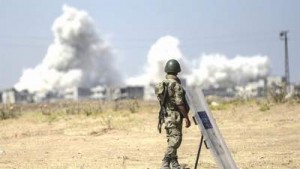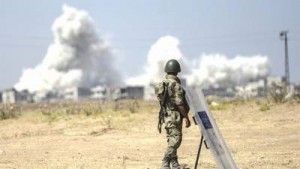Al Jazeera
Can Kasapoglu

With the Turkish army targeting Kurdish People’s Protection Units (YPG) fighters in northern Syria while the Royal Saudi Air Force deploys fighter jets to Turkey’s Incirlik air base, the prospect is raised of a joint Turkish-Saudi incursion.
To predict Ankara’s next move, first, one should understand the Turkish administration’s geopolitical perspective and threat perceptions.
Under the cover of the Russian air-ground campaign, the Syrian army has not only reversed control of terrain massively, but has changed the balance of power by clearing key rebel bastions along the primary axis of the conflict.
More alarmingly for Turkey, recent developments on the battleground caught many Turkish analysts off-guard.
As Bashar al-Assad’s forces were preparing for a decisive siege of Aleppo, Ankara focused on halting the regime’s northern push and preventing a large influx of refugees.
Dangerous gains
Meanwhile, shockingly, YPG, the armed wing of the Kurdistan Worker’s Party (PKK) affiliated Syrian Kurdish Democratic Union Party (PYD), has started to make dangerous gains between Tal Rifaat and Azaz, having captured a key jumping-off point, the Menagh air base.
In the eyes of Turkish decision-makers, if there is something worse than seeing a regime takeover in Azaz, it might be a complete PYD corridor along its frontier with Syria.
More importantly, the YPG fighters are now receiving close air-support from the Russians. This is a game-changer for Turkey.
First, close air-support operations necessitate co-ordination between the ground elements and supporting air platforms. Especially when belligerents fight in close proximities, adjusting “fire support co-ordination lines” is important to prevent dangerous friendly-fire situations.
Thus, YPG’s recent success in receiving Russian close air-support suggests the presence of Russian forward air controllers among the YPG fighters.
Secondly, the military geostrategic consistency between the northern offensive of Assad’s forces and the YPG’s push for critical positions between Tal Rifat and Azaz completes the alarming picture for Ankara.
Clearly, the Turkish administration has been monitoring a menacing harmony on its doorstep between the YPG, the regime, and the Russian contingent.
Turkey’s current moves and limited military operations through stand-off artillery fire should not be confused with Ankara’s “great expectations” at the very outset of the civil war.
Clearly, at the beginning of the Arab Spring, the Turkish elite saw opportunities for broadening Turkey’s sphere of influence through rise of conservative, Muslim Brotherhood-offshoots in the region, particularly in Egypt, Tunisia, and Syria.
Thereby, Ankara’s support for the moderate Syrian opposition and a no-fly zone over Syria were not much different from Turkey’s political support to the Morsi government in Egypt in terms grand strategy.
Asking the right question
However, the current situation is more about defending territorial unity of the republic than restoring imperial foothold in Turkey’s historical hinterland.
Put simply, Ankara’s strategic reading depends on a volatile geopolitical calculus assessing that collapse of the Sykes-Picot status quo, coupled with mounting PKK terrorism in the home front, would not be a bearable burden for Turkey’s national security.
This explains why Ankara runs the risk of a rhetorical exchange with the United States, and downing a Russian aircraft in the absence of tangible Western support.
At this point, let’s ask that topical question; could Turkey and Saudi Arabia launch a joint operation in Syria?
For a precise answer, we need to go over the key political-military parameters.
As much as the Turkish army has one of the best artillery capabilities in the region, recent military history proves that artillery fire alone would not be decisive enough to repel YPG elements from the Menagh airbase. Thus, a land incursion supported by considerable air superiority would be needed. Naturally, following the Su-24 incident, Ankara would be hesitant to fly over the Syrian airspace. At this point, the “Saudi option” comes into the picture. Although the Royal Saudi Army is not structured as an expeditionary force, RSAF could support a limited Turkish incursion.
Yet, in doing so, the burgeoning Turkish – Saudi coalition should deploy more than only four F-15SA strike-fighters to Turkey’s Incirlik Base.
Moreover, any Royal Saudi Air Force missions would be flown under the Russian air defence threat in northern Syria, and Riyadh is not likely to risk a direct confrontation. Besides, Washington would not be happy to see the Saudis flying anti-PYD missions, and that would remain an important political drawback. Opposing to the US and Russia at the same time could be costly for the Kingdom.
Nevertheless, Ankara and Riyadh could still work on a plan that would “extend” the limits of an anti-ISIL mission. In this scenario, Turkey could launch a limited incursion for deterring the YPG advance towards Azaz and setting a safe zone to respond refugee influx, while the Saudis could fly with additional rules of engagement for “protecting friendly forces” on the ground.
In such a case, the Kremlin’s and Tehran’s strategies for further escalation, as well as Washington’s stance, would be the key determinants to either ignite a regional war, or pave the ground for an international consensus over the future of Syria.



